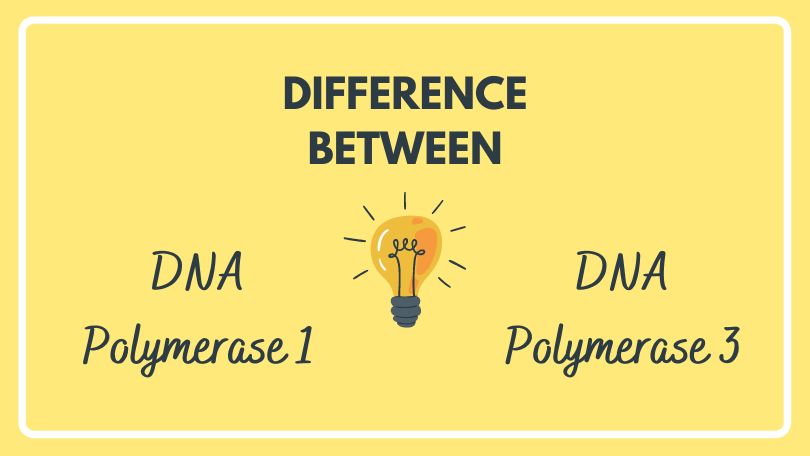There are enzymes in the family known as DNA Polymerase that can replicate genetic information stored in the nucleic acid DNA. This makes it possible to create an exact replica. In order to synthesize DNA molecules from nucleoside triphosphates, DNA Polymerase is needed. These are the building blocks of DNA, which are made up of nucleotides.
As a consequence, they aid in the replication of a live organism’s whole genome prior to cell division. They’re also necessary for a cell’s genome to remain intact for the duration of its life cycle. DNA Polymerase is essential to the survival of all organisms that utilised DNA as a genetic code. DNA polymerases are required by all living organisms, whether they are single-celled or multi-celled.
There are a variety of DNA Polymerases available on the market. DNA Polymerases come in a variety of varieties, each serving a specific purpose. DNA Polymerase types 1 and 3 are the most frequent.
DNA Polymerase 1 Vs. DNA Polymerase 3
Unlike DNA Polymerase 3, DNA Polymerase 1 is essential for the replication of the DNA. Pol 1 is another frequent name for it. Genomic replication in prokaryotes relies on DNA Polymerase 3. One of the most prevalent names for this enzyme is the holoenzyme.
DNA Polymerase 1
There are two types of DNA polymerase: DNA Polymerase 1 and DNA Polymerase 2. Arthur Kornberg was the first to find it back in 1956. The Pola gene encodes it. For the replication of the DNA, DNA Polymerase 1 is used. As a result, it aids in the creation of a new strand of DNA. Filling gaps, mending damage, and recombining DNA are all made easier by DNA Polymerase 1.
When DNA is replicated, a primer for RNA is inserted into the trailing strand of DNA. Removal of the RNA primer is carried out by DNA Polymerase 1. As a result, it aids in the formation of DNA in the 5′ to 3′ orientation. DNA is synthesized by DNA Polymerase 1 at a rate of 10 to 20 nucleotides per second on average.
DNA Polymerase 3
For prokaryotes, DNA Polymerase 3 is an important enzyme that aids in the replication of DNA. The template strand must be used to couple the incoming nucleotides. DNA Polymerase 3 also aids in the process of DNA proofreading. After analyzing the newly added nucleotides, the DNA Polymerase eliminates any mismatches and resynthesizes the strand. It contributes to the genome’s overall stability.
Thomas Kornberg and Malcolm Gefter discovered DNA Polymerase 3 in 1970. Holoenzyme is another popular name for this enzyme. It is a member of DNA Polymerase Family C or Type C. Exonuclease activity of the DNA Polymerase 3 is 3′-5′
Difference Between DNA Polymerase 1 and 3
- Prokaryotic DNA replication relies on DNA Polymerase 3, whereas eukaryotic DNA replication relies on DNA Polymerase 1.
- In 1956, DNA Polymerase 1 was discovered, whereas in 1970, DNA Polymerase 3 was found.
- Arthur Kornberg was the first to discover DNA Polymerase 1. Thomas Kornberg and Malcolm Gefter, on the other hand, found DNA Polymerase 3.
- DNA Polymerase 1 (Pol 1) and DNA Polymerase 3 (Holoenzyme) are two of the most widely referred to enzymes in DNA replication.
- In contrast to DNA Polymerase 1, which is a member of the DNA Polymerase family A, DNA Polymerase 3 is a member of the DNA Polymerase family C.
- In order to create DNA, DNA Polymerase requires the RNA primer, which is removed by DNA Polymerase 1.
- A replication fork’s lagging strand is solely affected by DNA Polymerase 1, whereas both the lagging and leading strand are affected by DNA Polymerase 3.
Conclusion
In bacterial DNA replication, the DNA Polymerase 1 and 3 are two distinct forms of DNA Polymerases. In order to aid in DNA proofreading, both of these exhibit a 5′ to 3′ polymerizing activity.
Exonuclease activity is also seen. Nevertheless, the DNA Polymerase 1 and the DNA Polymerase 3 are both distinct from each other in that the DNA Polymerase 1’s primary function is to remove the RNA primer from the 5 to 3′ direction, whereas the DNA Polymerase 3’s primary function is to add deoxyribonucleic acids to the 3′ end of the strand.

